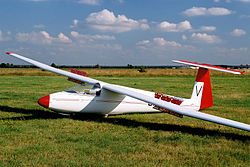PZL Bielsko SZD-30
| SZD-30 pirate | |
|---|---|

|
|
| Type: | Multipurpose glider |
| Design country: | |
| Manufacturer: |
PZL |
| First flight: |
May 19, 1966 |
| Number of pieces: |
833 |
The PZL Bielsko SZD-30 “Pirate” is a single-seat, multi-purpose glider that is mainly used for training pilots on a two-seat training glider after completing their training. The shoulder decker is made of wood materials. The Pirat is one of the few types of gliders with a three-part wing and is suitable for all types of gliding, including simple aerobatics .
history
The first flight took place on May 19, 1966 with Adam Zientek. The designer was Jerzy Smielkiewicz. The following versions were produced:
- SZD-30 - first serial version with small rudder and canopy that opens to the right, which had to be pushed forward approx. 3 cm for emergency release after unlocking.
- SZD-30C - third series version with redesigned cab and improved control properties, revised and modernized from 1978. The most noticeable change in the C version was the new canopy that can be pushed forward.
The rudder of the basic version was significantly lengthened in the lower area before that. Airplanes of the original version were equipped with the larger rudder on request during the major overhaul at the manufacturer. The Pirat was the GST's standard trainer aircraft in the 1980s. Both of the C “Pirates” (serial numbers P-808 and P-809), originally supplied to the aviation group by Carl-Zeiss-Jena and operated by GST, no longer exist, and C-Pirates are no longer permitted in Germany.
The aircraft was exported to 24 countries, e.g. B. Argentina, Australia, Egypt, GDR , North Korea , New Zealand, USA , Soviet Union and Venezuela . The GST of the GDR flew the "Pirat" of both versions from 1967 in a number of 217. The abbreviation SZD (Szybowcowy Zakład Doświadczalny) roughly means glider development plant .
The pirate is an undemanding, good-natured training aircraft made of wood, on which GST pilots made their first flights in single-seaters in the 1980s and experienced pilots were able to gain further flight experience. The flight performance is sufficient for this purpose. The rudders are well coordinated, but on the first flights you have to pay attention to the high sensitivity, especially of the elevator, compared to the clumsy double-seaters. The change from a 45 ° incline to an opposite 45 ° incline only takes 3 seconds.
construction
The aircraft is a completely wooden structure. The three-part structure consists of a central middle section and a removable outer wing on each side with a larger V-position . The ailerons and the "airbrakes" (actually they are disruptive plates) are moved via rods, the elevator, rudder and trim tabs via cables. All the rudders and the rear part of the wings are covered with fabric. The rigid and unsprung chassis is braked, the sprung spur cannot be retracted. The lever for the badly acting wheel brake is located on the control stick. It presses the wheel from above using a Bowden cable with a sheet metal. The seat is adjustable. The rudder pedals can also be adjusted in flight (brown cable). The seat has a built-in "on-board toilet". There are storage spaces behind the seat. In the lower storage space there is the mostly dismantled oxygen bottle for high-altitude flights and the battery for the radio that was not originally standard. The ventilation is very effective. In addition to the sliding side window, there is a fresh air supply that opens a flap above the dashboard, which is still under the original hood, from which the air flows directly into the pilot's face.
The aircraft is designed for aerobatics and for the characters loop , turn , on - and downturn admitted. A spin can be eliminated after half a turn.
Technical specifications
| Parameter | SZD-30 | SZD-30 C |
|---|---|---|
| Years of construction | 1966-1988 | 1978–? |
| Manufacturer | PZL Bielsko | WSK-Świdnik |
| Constructor (s) | Jerzy Smielkiewicz | |
| crew | 1 | |
| span | 15.00 m | |
| length | 6.86 m | 6.95 m |
| height | 1.67 m | |
| Wing area | 13.80 m² | |
| Elongation | 16.3 | |
| Central wing profile | FX 61-168 | |
| Outer wing profile | FX 60-1261 | |
| Glide ratio | 31.2 at 83 km / h | |
| Slightest sinking | 0.70 m / s at 75 km / h | 0.60 m / s at 73 km / h |
| payload | ~ 115 kg | |
| Minimum payload | 75 kg | |
| Max. Takeoff mass | 370 kg | |
| Top speed | 250 km / h | |
| Minimum speed | 60 km / h | |
| Normal speed | 80 km / h for straight ahead and curves with a 30 ° incline | |
| Cornering speed with a 45 ° incline | 90 km / h | |
| Cornering speed with a 60 ° incline | 100 km / h | |
| Load multiple | + 6.0 / -3.5 g | + 5.3 / -2.65 g |
literature
- Kazimierz Wojciech Chudzinski: Polish gliders . Volume 1: 1945-1970. Verlag für Technik und Handwerk, Baden-Baden 2014, ISBN 978-3-88180-454-7 .